check engine JEEP WRANGLER 2007 JK / 3.G Owner's Manual
[x] Cancel search | Manufacturer: JEEP, Model Year: 2007, Model line: WRANGLER, Model: JEEP WRANGLER 2007 JK / 3.GPages: 467, PDF Size: 8.83 MB
Page 380 of 467
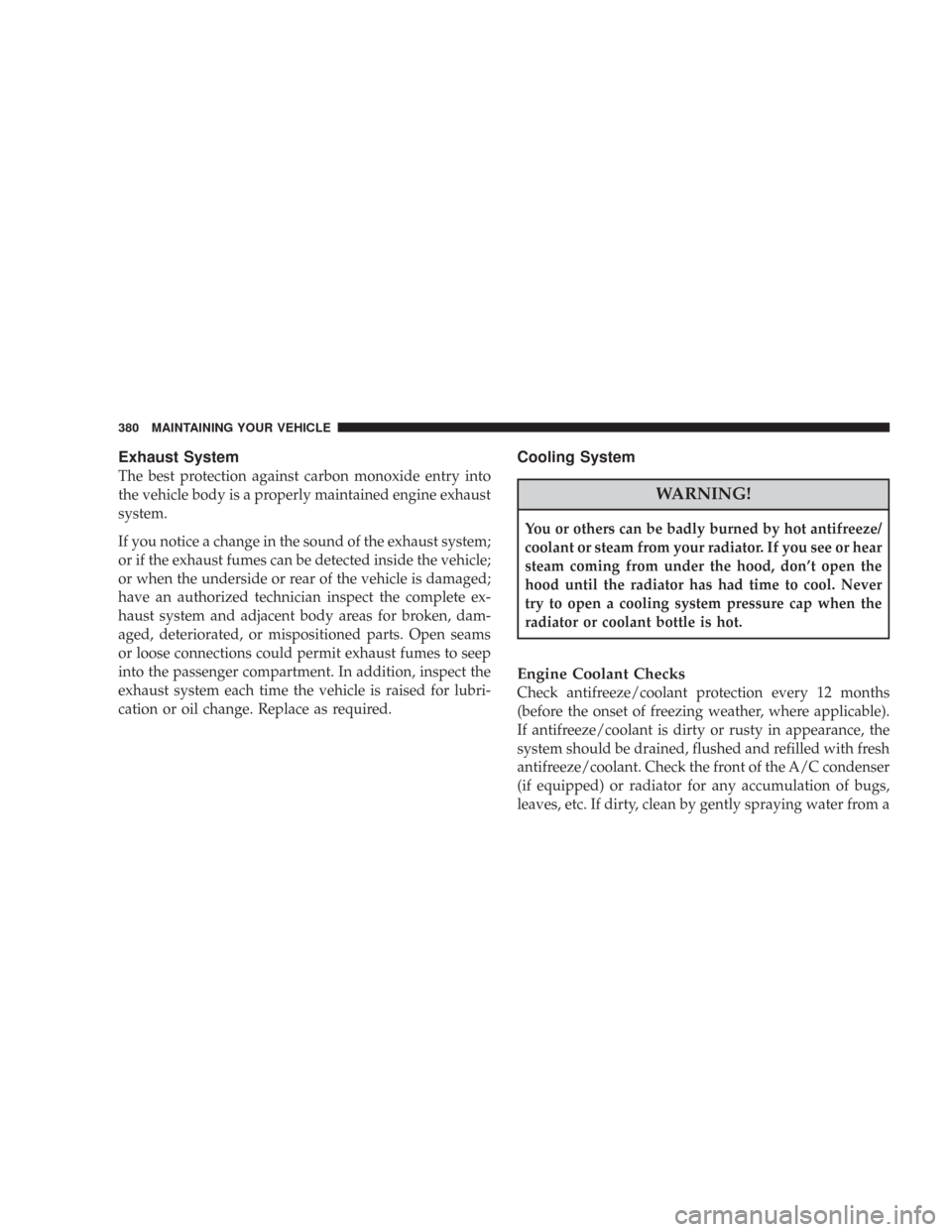
Exhaust System
The best protection against carbon monoxide entry into
the vehicle body is a properly maintained engine exhaust
system.
If you notice a change in the sound of the exhaust system;
or if the exhaust fumes can be detected inside the vehicle;
or when the underside or rear of the vehicle is damaged;
have an authorized technician inspect the complete ex-
haust system and adjacent body areas for broken, dam-
aged, deteriorated, or mispositioned parts. Open seams
or loose connections could permit exhaust fumes to seep
into the passenger compartment. In addition, inspect the
exhaust system each time the vehicle is raised for lubri-
cation or oil change. Replace as required.
Cooling System
WARNING!
You or others can be badly burned by hot antifreeze/
coolant or steam from your radiator. If you see or hear
steam coming from under the hood, don’t open the
hood until the radiator has had time to cool. Never
try to open a cooling system pressure cap when the
radiator or coolant bottle is hot.
Engine Coolant Checks
Check antifreeze/coolant protection every 12 months
(before the onset of freezing weather, where applicable).
If antifreeze/coolant is dirty or rusty in appearance, the
system should be drained, flushed and refilled with fresh
antifreeze/coolant. Check the front of the A/C condenser
(if equipped) or radiator for any accumulation of bugs,
leaves, etc. If dirty, clean by gently spraying water from a
380 MAINTAINING YOUR VEHICLE
Page 381 of 467
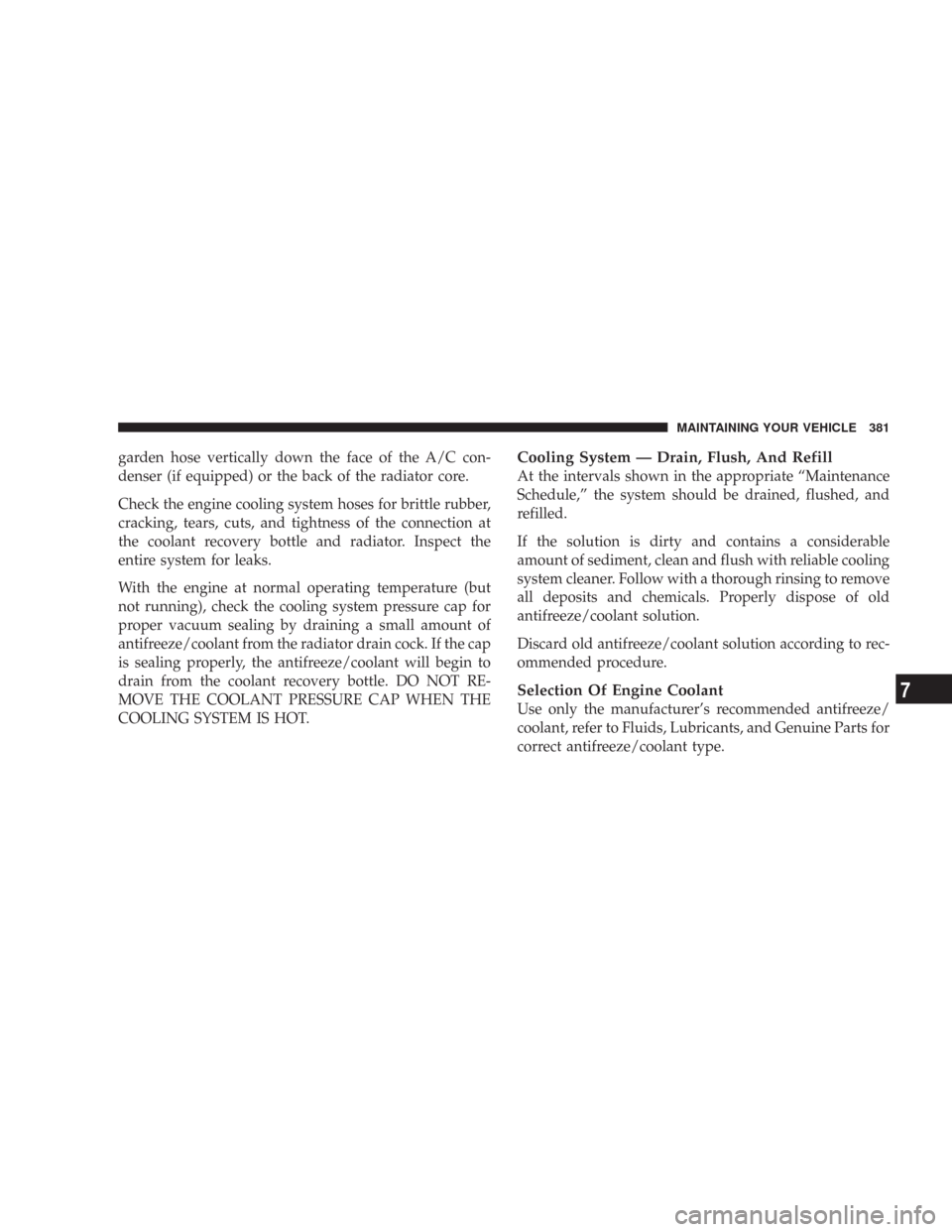
garden hose vertically down the face of the A/C con-
denser (if equipped) or the back of the radiator core.
Check the engine cooling system hoses for brittle rubber,
cracking, tears, cuts, and tightness of the connection at
the coolant recovery bottle and radiator. Inspect the
entire system for leaks.
With the engine at normal operating temperature (but
not running), check the cooling system pressure cap for
proper vacuum sealing by draining a small amount of
antifreeze/coolant from the radiator drain cock. If the cap
is sealing properly, the antifreeze/coolant will begin to
drain from the coolant recovery bottle. DO NOT RE-
MOVE THE COOLANT PRESSURE CAP WHEN THE
COOLING SYSTEM IS HOT.Cooling System — Drain, Flush, And Refill
At the intervals shown in the appropriate “Maintenance
Schedule,” the system should be drained, flushed, and
refilled.
If the solution is dirty and contains a considerable
amount of sediment, clean and flush with reliable cooling
system cleaner. Follow with a thorough rinsing to remove
all deposits and chemicals. Properly dispose of old
antifreeze/coolant solution.
Discard old antifreeze/coolant solution according to rec-
ommended procedure.
Selection Of Engine Coolant
Use only the manufacturer’s recommended antifreeze/
coolant, refer to Fluids, Lubricants, and Genuine Parts for
correct antifreeze/coolant type.
MAINTAINING YOUR VEHICLE 381
7
Page 383 of 467
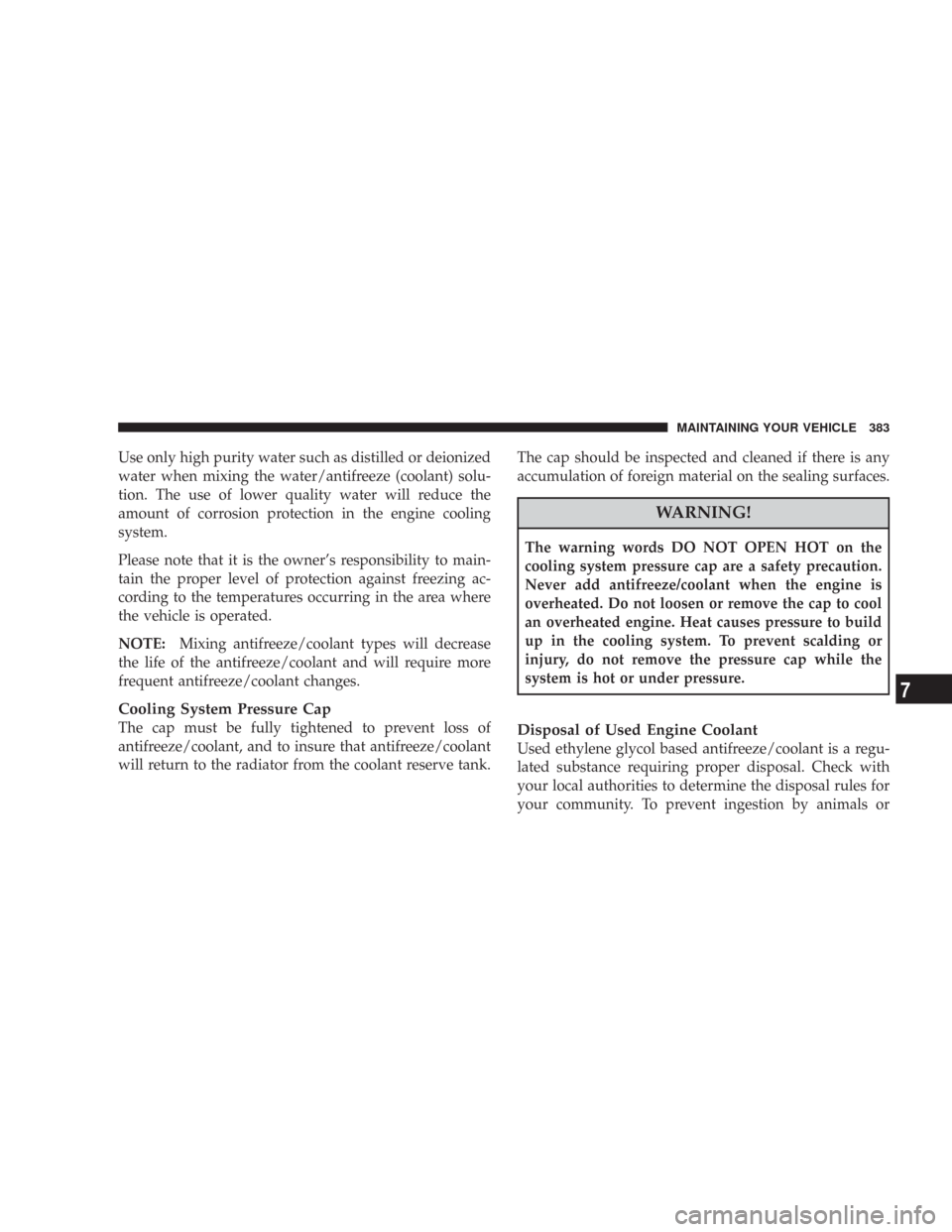
Use only high purity water such as distilled or deionized
water when mixing the water/antifreeze (coolant) solu-
tion. The use of lower quality water will reduce the
amount of corrosion protection in the engine cooling
system.
Please note that it is the owner’s responsibility to main-
tain the proper level of protection against freezing ac-
cording to the temperatures occurring in the area where
the vehicle is operated.
NOTE:Mixing antifreeze/coolant types will decrease
the life of the antifreeze/coolant and will require more
frequent antifreeze/coolant changes.
Cooling System Pressure Cap
The cap must be fully tightened to prevent loss of
antifreeze/coolant, and to insure that antifreeze/coolant
will return to the radiator from the coolant reserve tank.The cap should be inspected and cleaned if there is any
accumulation of foreign material on the sealing surfaces.
WARNING!
The warning words DO NOT OPEN HOT on the
cooling system pressure cap are a safety precaution.
Never add antifreeze/coolant when the engine is
overheated. Do not loosen or remove the cap to cool
an overheated engine. Heat causes pressure to build
up in the cooling system. To prevent scalding or
injury, do not remove the pressure cap while the
system is hot or under pressure.
Disposal of Used Engine Coolant
Used ethylene glycol based antifreeze/coolant is a regu-
lated substance requiring proper disposal. Check with
your local authorities to determine the disposal rules for
your community. To prevent ingestion by animals or
MAINTAINING YOUR VEHICLE 383
7
Page 384 of 467
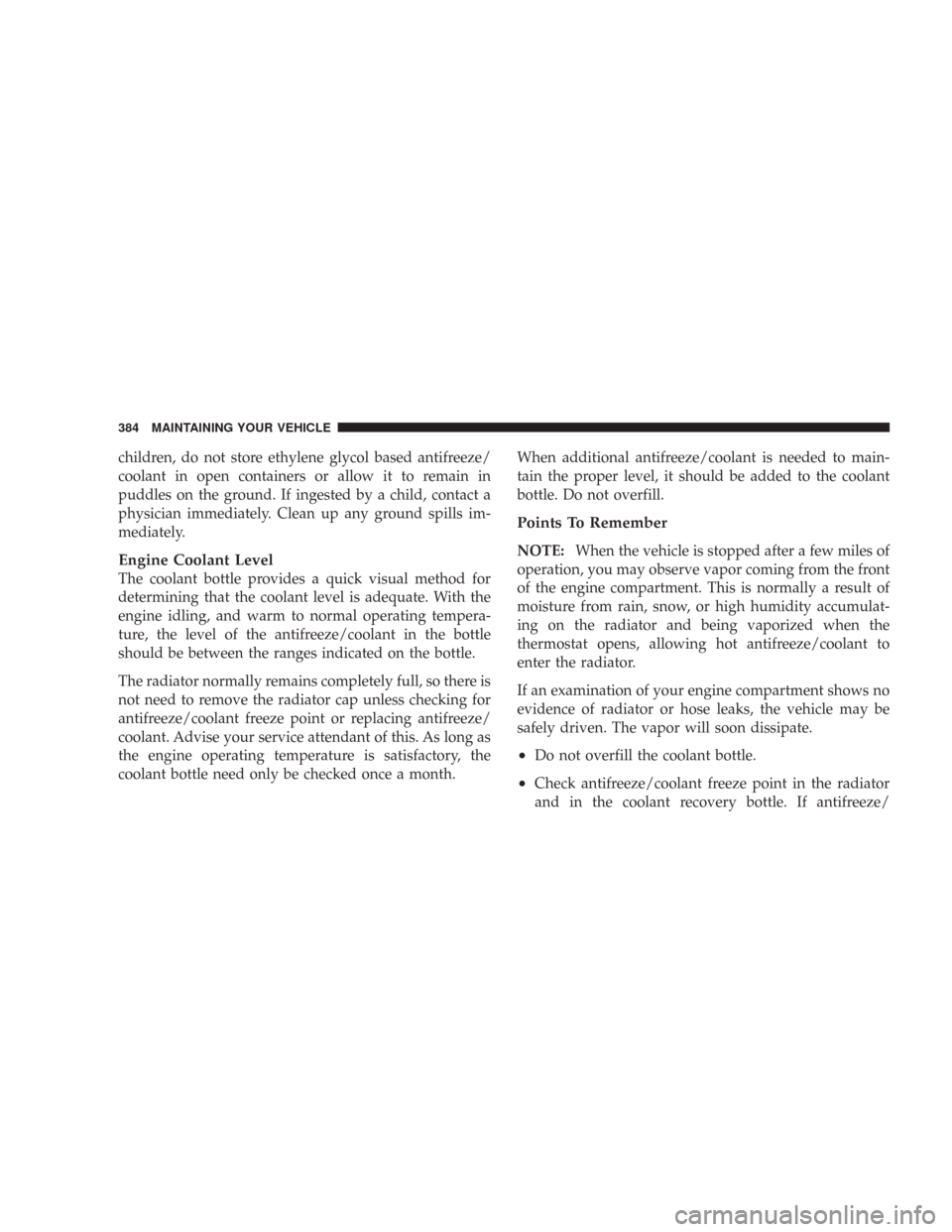
children, do not store ethylene glycol based antifreeze/
coolant in open containers or allow it to remain in
puddles on the ground. If ingested by a child, contact a
physician immediately. Clean up any ground spills im-
mediately.
Engine Coolant Level
The coolant bottle provides a quick visual method for
determining that the coolant level is adequate. With the
engine idling, and warm to normal operating tempera-
ture, the level of the antifreeze/coolant in the bottle
should be between the ranges indicated on the bottle.
The radiator normally remains completely full, so there is
not need to remove the radiator cap unless checking for
antifreeze/coolant freeze point or replacing antifreeze/
coolant. Advise your service attendant of this. As long as
the engine operating temperature is satisfactory, the
coolant bottle need only be checked once a month.When additional antifreeze/coolant is needed to main-
tain the proper level, it should be added to the coolant
bottle. Do not overfill.
Points To Remember
NOTE:When the vehicle is stopped after a few miles of
operation, you may observe vapor coming from the front
of the engine compartment. This is normally a result of
moisture from rain, snow, or high humidity accumulat-
ing on the radiator and being vaporized when the
thermostat opens, allowing hot antifreeze/coolant to
enter the radiator.
If an examination of your engine compartment shows no
evidence of radiator or hose leaks, the vehicle may be
safely driven. The vapor will soon dissipate.
•Do not overfill the coolant bottle.
•Check antifreeze/coolant freeze point in the radiator
and in the coolant recovery bottle. If antifreeze/
384 MAINTAINING YOUR VEHICLE
Page 387 of 467
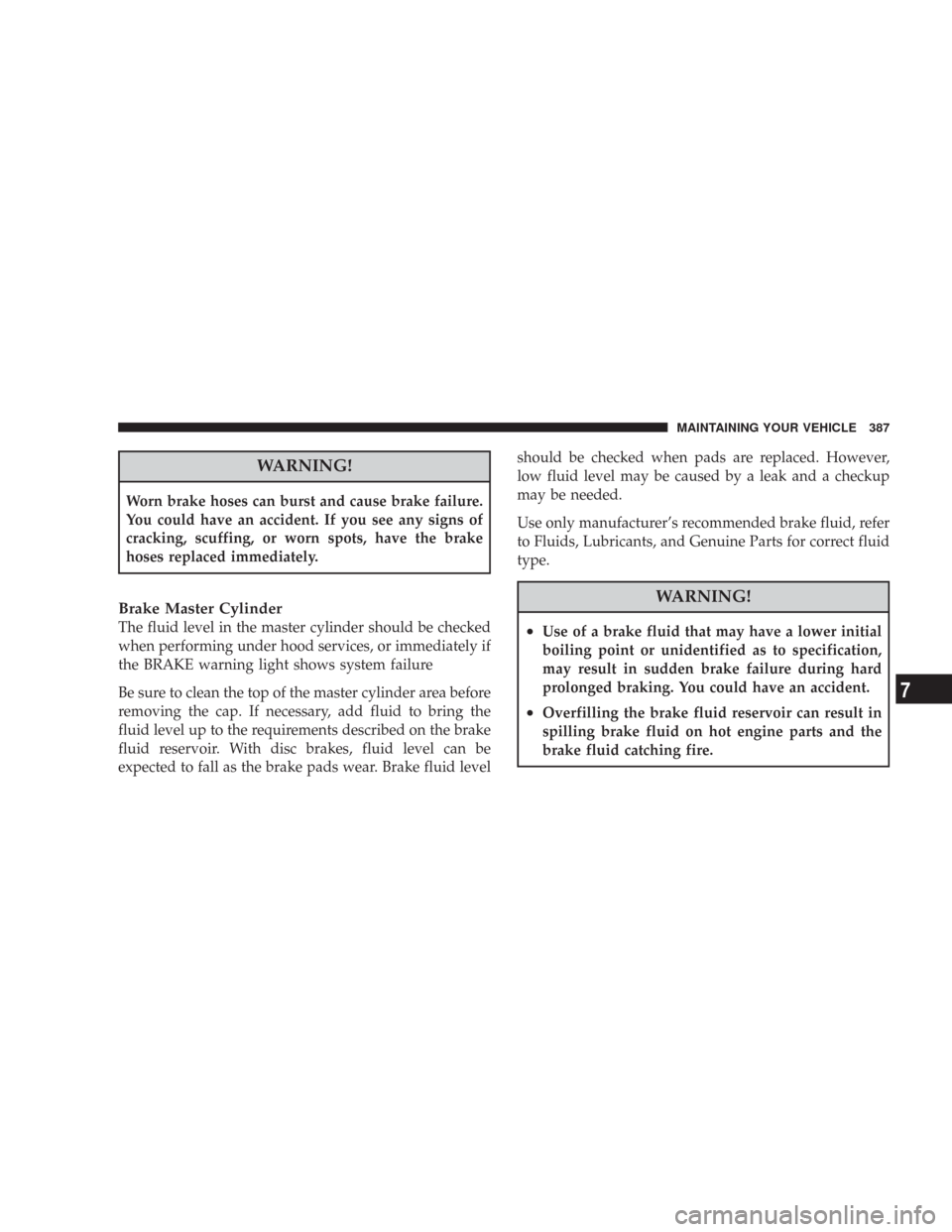
WARNING!
Worn brake hoses can burst and cause brake failure.
You could have an accident. If you see any signs of
cracking, scuffing, or worn spots, have the brake
hoses replaced immediately.
Brake Master Cylinder
The fluid level in the master cylinder should be checked
when performing under hood services, or immediately if
the BRAKE warning light shows system failure
Be sure to clean the top of the master cylinder area before
removing the cap. If necessary, add fluid to bring the
fluid level up to the requirements described on the brake
fluid reservoir. With disc brakes, fluid level can be
expected to fall as the brake pads wear. Brake fluid levelshould be checked when pads are replaced. However,
low fluid level may be caused by a leak and a checkup
may be needed.
Use only manufacturer’s recommended brake fluid, refer
to Fluids, Lubricants, and Genuine Parts for correct fluid
type.
WARNING!
•Use of a brake fluid that may have a lower initial
boiling point or unidentified as to specification,
may result in sudden brake failure during hard
prolonged braking. You could have an accident.
•Overfilling the brake fluid reservoir can result in
spilling brake fluid on hot engine parts and the
brake fluid catching fire.
MAINTAINING YOUR VEHICLE 387
7
Page 389 of 467
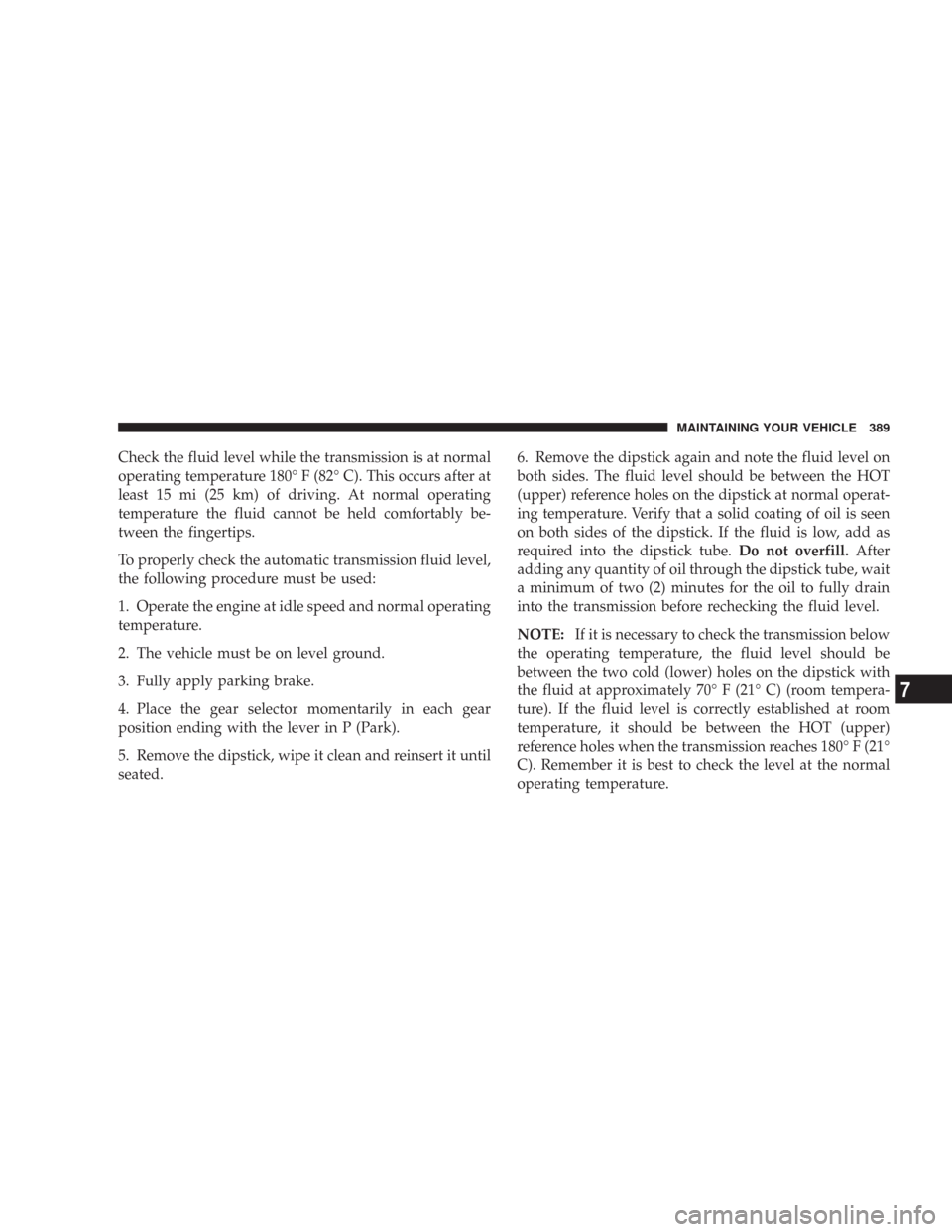
Check the fluid level while the transmission is at normal
operating temperature 180° F (82° C). This occurs after at
least 15 mi (25 km) of driving. At normal operating
temperature the fluid cannot be held comfortably be-
tween the fingertips.
To properly check the automatic transmission fluid level,
the following procedure must be used:
1. Operate the engine at idle speed and normal operating
temperature.
2. The vehicle must be on level ground.
3. Fully apply parking brake.
4. Place the gear selector momentarily in each gear
position ending with the lever in P (Park).
5. Remove the dipstick, wipe it clean and reinsert it until
seated.6. Remove the dipstick again and note the fluid level on
both sides. The fluid level should be between the HOT
(upper) reference holes on the dipstick at normal operat-
ing temperature. Verify that a solid coating of oil is seen
on both sides of the dipstick. If the fluid is low, add as
required into the dipstick tube.Do not overfill.After
adding any quantity of oil through the dipstick tube, wait
a minimum of two (2) minutes for the oil to fully drain
into the transmission before rechecking the fluid level.
NOTE:If it is necessary to check the transmission below
the operating temperature, the fluid level should be
between the two cold (lower) holes on the dipstick with
the fluid at approximately 70° F (21° C) (room tempera-
ture). If the fluid level is correctly established at room
temperature, it should be between the HOT (upper)
reference holes when the transmission reaches 180° F (21°
C). Remember it is best to check the level at the normal
operating temperature.
MAINTAINING YOUR VEHICLE 389
7
Page 393 of 467

Following off-road usage, completely inspect the under-
body of your vehicle. Check tires, body structure, steer-
ing, suspension and exhaust system for damage. Check
threaded fasteners for looseness, particularly on the
chassis, drivetrain components, steering and suspension.
Retighten, if required, to torque values specified in the
Service Manual. Also check for accumulations of vegeta-
tion or brush that could become a fire hazard, or conceal
damage to fuel lines, brake hoses, axle pinion seals, and
propeller shafts. Check air conditioning drain tube on the
lower dash wall in the engine compartment for mud or
debris, and clean as required. A plugged tube will
adversely affect air conditioning performance.CAUTION!
Under frequent heavy-duty driving conditions,
change all lubricants, and lubricate body compo-
nents more often than in normal service to prevent
excessive wear.
Appearance Care And Protection From Corrosion
Protection Of Body And Paint From Corrosion
Vehicle body care requirements vary according to geo-
graphic locations and usage. Chemicals that make roads
passable in snow and ice, and those that are sprayed on
trees and road surfaces during other seasons, are highly
corrosive to the metal in your vehicle. Outside parking,
which exposes your vehicle to airborne contaminants,
road surfaces on which the vehicle is operated, extreme
MAINTAINING YOUR VEHICLE 393
7
Page 418 of 467
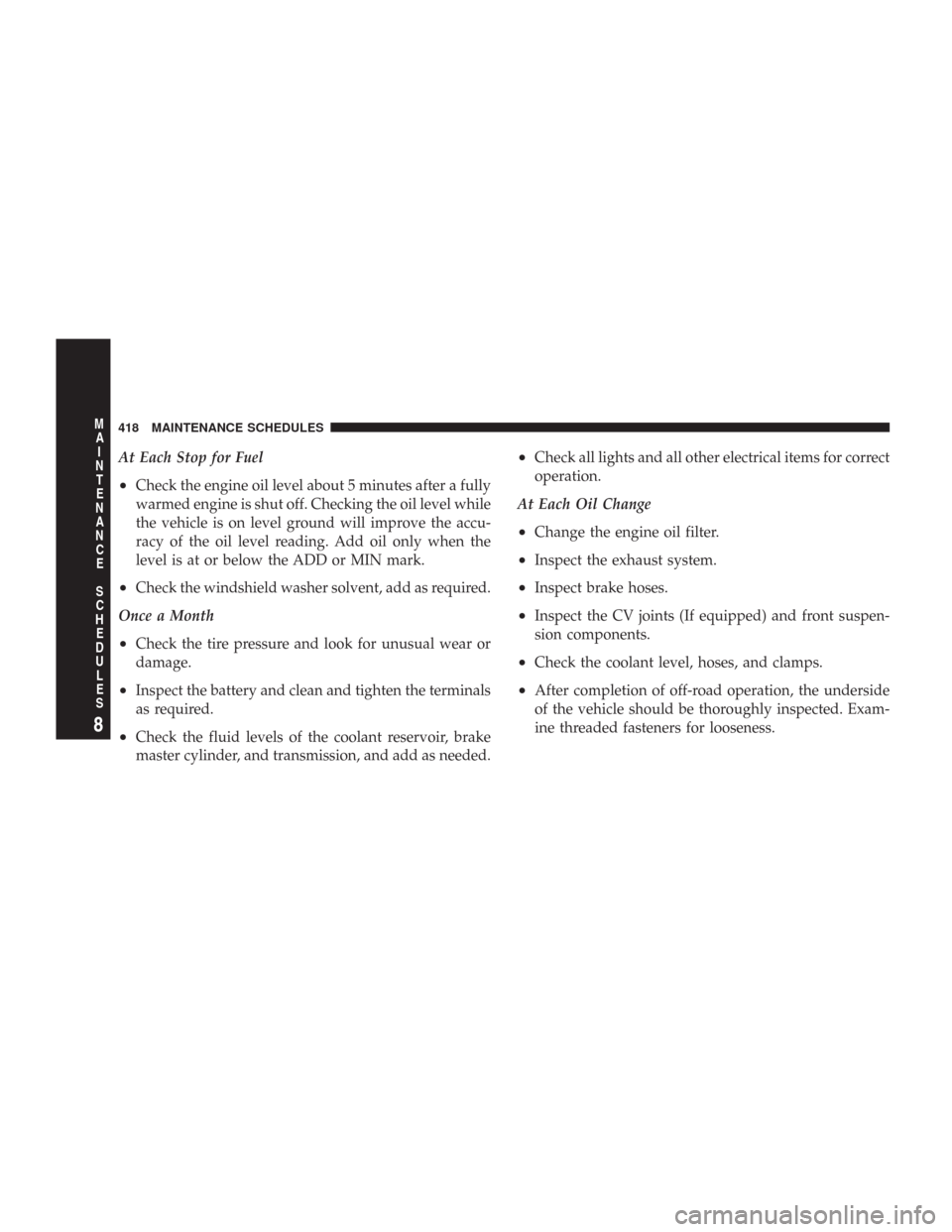
At Each Stop for Fuel
•Check the engine oil level about 5 minutes after a fully
warmed engine is shut off. Checking the oil level while
the vehicle is on level ground will improve the accu-
racy of the oil level reading. Add oil only when the
level is at or below the ADD or MIN mark.
•Check the windshield washer solvent, add as required.
Once a Month
•Check the tire pressure and look for unusual wear or
damage.
•Inspect the battery and clean and tighten the terminals
as required.
•Check the fluid levels of the coolant reservoir, brake
master cylinder, and transmission, and add as needed.
•Check all lights and all other electrical items for correct
operation.
At Each Oil Change
•Change the engine oil filter.
•Inspect the exhaust system.
•Inspect brake hoses.
•Inspect the CV joints (If equipped) and front suspen-
sion components.
•Check the coolant level, hoses, and clamps.
•After completion of off-road operation, the underside
of the vehicle should be thoroughly inspected. Exam-
ine threaded fasteners for looseness.
418 MAINTENANCE SCHEDULES
8
M
A
I
N
T
E
N
A
N
C
E
S
C
H
E
D
U
L
E
S
Page 450 of 467
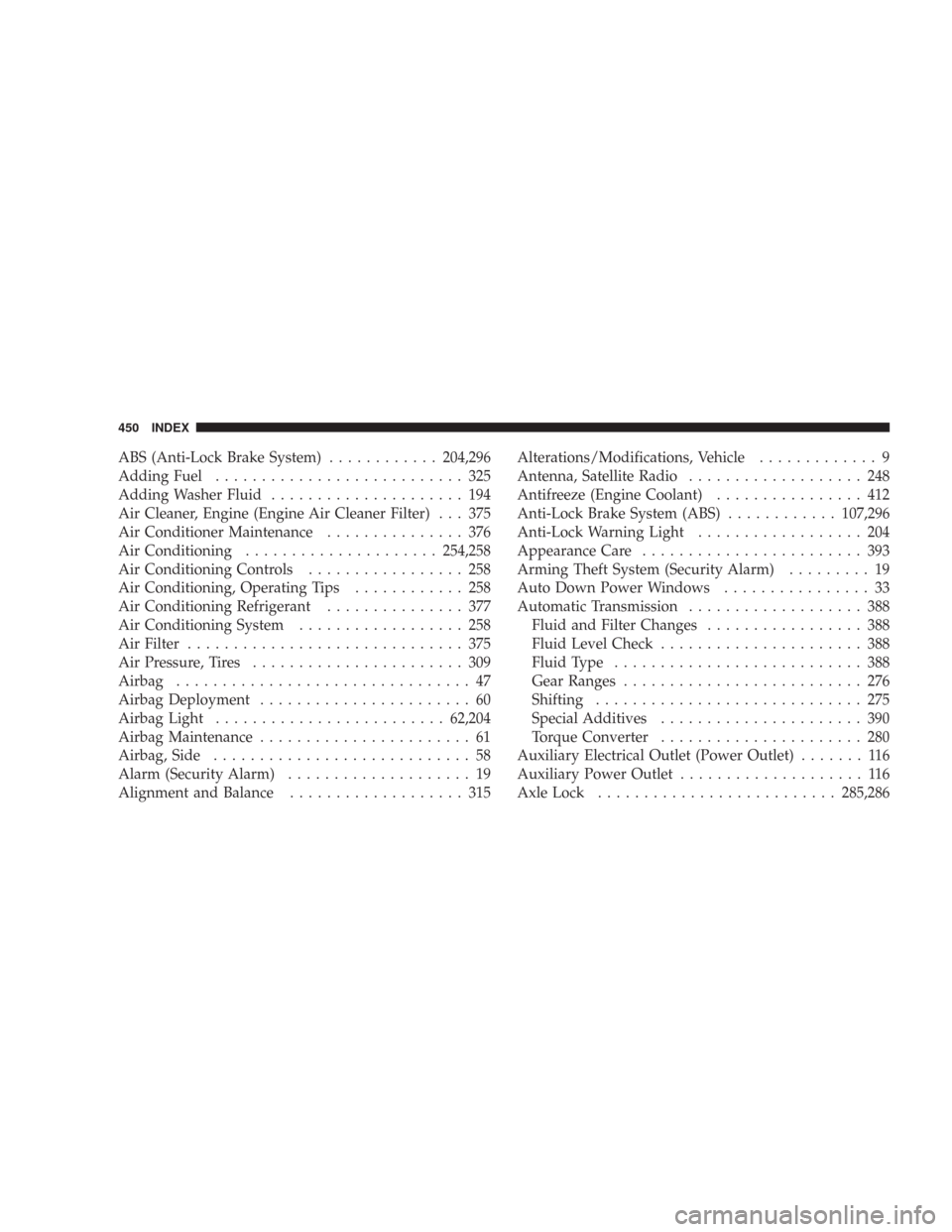
ABS (Anti-Lock Brake System)............204,296
Adding Fuel........................... 325
Adding Washer Fluid..................... 194
Air Cleaner, Engine (Engine Air Cleaner Filter) . . . 375
Air Conditioner Maintenance............... 376
Air Conditioning.....................254,258
Air Conditioning Controls................. 258
Air Conditioning, Operating Tips............ 258
Air Conditioning Refrigerant............... 377
Air Conditioning System.................. 258
Air Filter.............................. 375
Air Pressure, Tires....................... 309
Airbag................................ 47
Airbag Deployment....................... 60
Airbag Light.........................62,204
Airbag Maintenance....................... 61
Airbag, Side............................ 58
Alarm (Security Alarm).................... 19
Alignment and Balance................... 315Alterations/Modifications, Vehicle............. 9
Antenna, Satellite Radio................... 248
Antifreeze (Engine Coolant)................ 412
Anti-Lock Brake System (ABS)............107,296
Anti-Lock Warning Light.................. 204
Appearance Care........................ 393
Arming Theft System (Security Alarm)......... 19
Auto Down Power Windows................ 33
Automatic Transmission................... 388
Fluid and Filter Changes................. 388
Fluid Level Check...................... 388
Fluid Type........................... 388
Gear Ranges.......................... 276
Shifting............................. 275
Special Additives...................... 390
Torque Converter...................... 280
Auxiliary Electrical Outlet (Power Outlet)....... 116
Auxiliary Power Outlet.................... 116
Axle Lock..........................285,286
450 INDEX
Page 452 of 467
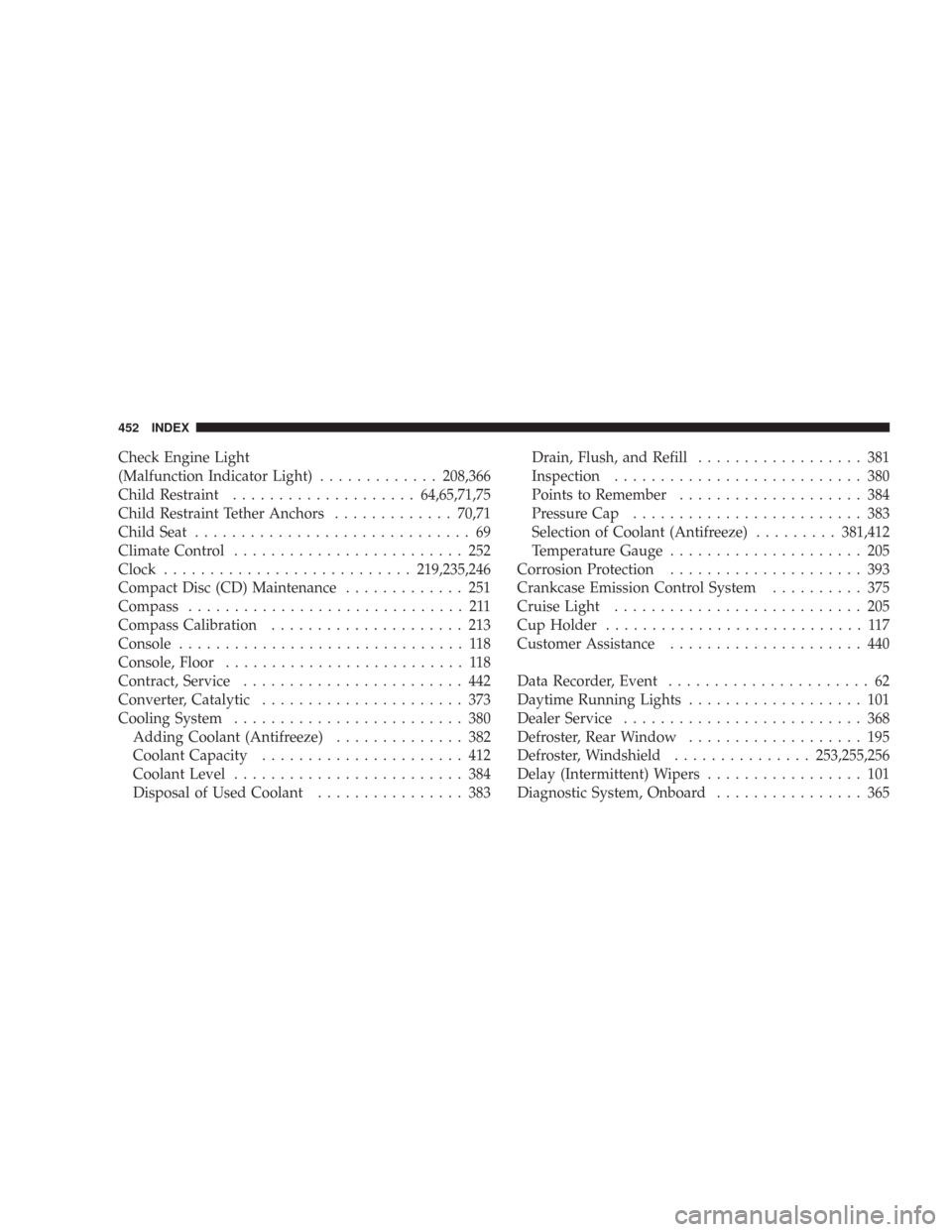
Check Engine Light
(Malfunction Indicator Light).............208,366
Child Restraint....................64,65,71,75
Child Restraint Tether Anchors.............70,71
Child Seat.............................. 69
Climate Control......................... 252
Clock...........................219,235,246
Compact Disc (CD) Maintenance............. 251
Compass.............................. 211
Compass Calibration..................... 213
Console............................... 118
Console, Floor.......................... 118
Contract, Service........................ 442
Converter, Catalytic...................... 373
Cooling System......................... 380
Adding Coolant (Antifreeze).............. 382
Coolant Capacity...................... 412
Coolant Level......................... 384
Disposal of Used Coolant................ 383Drain, Flush, and Refill.................. 381
Inspection........................... 380
Points to Remember.................... 384
Pressure Cap......................... 383
Selection of Coolant (Antifreeze).........381,412
Temperature Gauge..................... 205
Corrosion Protection..................... 393
Crankcase Emission Control System.......... 375
Cruise Light........................... 205
Cup Holder............................ 117
Customer Assistance..................... 440
Data Recorder, Event...................... 62
Daytime Running Lights................... 101
Dealer Service.......................... 368
Defroster, Rear Window................... 195
Defroster, Windshield...............253,255,256
Delay (Intermittent) Wipers................. 101
Diagnostic System, Onboard................ 365
452 INDEX